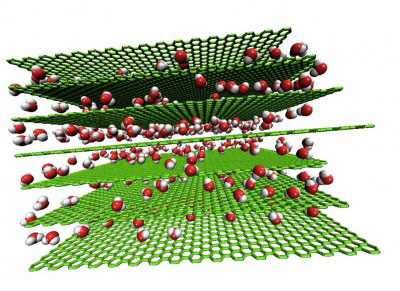| Jul 15, 2011 |
Graphite + water = the future of energy storage
|
|
(Nanowerk News) A combination of two ordinary materials – graphite and water – could produce energy storage systems that perform on par with lithium ion batteries, but recharge in a matter of seconds and have an almost indefinite lifespan.
|
|
Dr Dan Li, of the Monash University Department of Materials Engineering, and his research team have been working with a material called graphene, which could form the basis of the next generation of ultrafast energy storage systems.
|
|
"Once we can properly manipulate this material, your iPhone, for example, could charge in a few seconds, or possibly faster." said Dr Li.
|
|
Graphene is the result of breaking down graphite, a cheap, readily available material commonly used in pencils, into layers one atom thick. In this form, it has remarkable properties.
|
 |
| Graphene sheets.
|
|
Graphene is strong, chemically stable, an excellent conductor of electricity and, importantly, has an extremely high surface area.
|
|
Dr Li said these qualities make graphene highly suitable for energy storage applications.
|
|
"The reason graphene isn't being used everywhere is that these very thin sheets, when stacked into a usable macrostructure, immediately bond together, reforming graphite. When graphene restacks, most of the surface area is lost and it doesn't behave like graphene anymore."
|
|
Now, Dr Li and his team have discovered the key to maintaining the remarkable properties of separate graphene sheets: water. Keeping graphene moist – in gel form – provides repulsive forces between the sheets and prevents re-stacking, making it ready for real-world application.
|
|
"The technique is very simple and can easily be scaled up. When we discovered it, we thought it was unbelievable. We're taking two basic, inexpensive materials – water and graphite – and making this new nanomaterial with amazing properties," said Dr Li.
|
|
When used in energy devices, graphene gel significantly outperforms current carbon-based technology, both in terms of the amount of charge stored and how fast the charges can be delivered.
|
|
Dr Li said the benefits of developing this new nanotechnology extend beyond consumer electronics.
|
|
"High-speed, reliable and cost-effective energy storage systems are critical for the future viability of electricity from renewable resources. These systems are also the key to large-scale adoption of electrical vehicles.
|
|
"Graphene gel is also showing promise for use in water purification membranes, biomedical devices and sensors."
|
|
Dr Li has been working with graphene since 2006 and his team's research findings have recently been published in a number of prestigious journals including Advanced Materials, Angewandte Chemie and Chemical Communications.
|

